Men's Health Testicular Cancer, STD's, and TSE
You may wish to use this tool to search my site and the web
|
|
Site Map What's New Search
Indexed by the FreeFind Search Engine.
SORRY THIS PAGE IS UNDER CONSTRUCTION
better images will be available soon.
This page contains information on testicular cancer and testicular self-examination. Note: Graphics on this page show male genitals. If this offends you, you should exit now.

Lance Armstrong and Scott Hamilton are two athletes that have been recently diagnosed with Testicular Cancer.
Overview of Testicular Cancer
Another important risk factor is having or having had a condition known as cryptochidism, which is the failure of one or both of the testicles to descend into the scrotum before birth. This condition is usually corrected surgically, but if a male is born with an undescended testicle, he is at a much higher risk for testicular cancer than any other known group. Other identified or suspected risks are:
- having a family history of the cancer.
injury to the testicle(s)
hernia in the groin
mumps as an adolescent or young adult
and maternal use of DES (an other estrogens or hormones) while pregnant with a male child
Symptoms
- A small painless pea-sized lump.
A change in the size, shape, or texture of the testicle(s).
A feeling of heaviness in the scrotum or abdomine.
A dull ache in the groin.
A sudden accumulation of blood or fluid in the scrotum.
Pain in the scrotum that is not associated with injury.
Testicular cancer is a fast spreading cancer. While it may begin as a small lump on the testicle, it may spread to the lower abdominal regions and the area around the kidney within months. From there the cancer may spread into the lungs, liver and occationally the brain. Once it reaches this stage, it is extremely life threatening. Because this cancer spreads so rapidly, it is important to do a testicular examination every month from the time you reach puberty throughout your life. This exam takes only a few minutes and could result in saving your life.
How to perform a Testicular Self-Examination (or TSE)
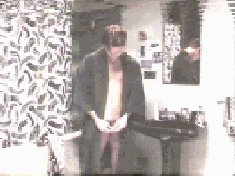 To perform a TSE, it is best to do this procedure after a warm shower or bath,
when the scrotum is relaxed and the testicles are hanging lower from the body.
To perform a TSE, it is best to do this procedure after a warm shower or bath,
when the scrotum is relaxed and the testicles are hanging lower from the body.
 Stand in front of a mirror and visually inspect your scrotum for any signs
of change, such as swelling or discoloration. It is normal for one testicle
to be larger and hang lower than the other.
Stand in front of a mirror and visually inspect your scrotum for any signs
of change, such as swelling or discoloration. It is normal for one testicle
to be larger and hang lower than the other.
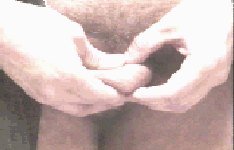 Next, place the pads of the index and middle finger of BOTH of your hands
under one testicle and place the thumbs of BOTH hands on top of the same
testicle. You check one testicle at a time using both hands.
Next, place the pads of the index and middle finger of BOTH of your hands
under one testicle and place the thumbs of BOTH hands on top of the same
testicle. You check one testicle at a time using both hands.
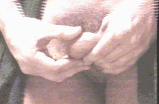
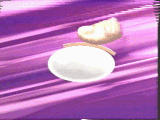
Gently squeeze the first testicle with the thumbs and fingers and "roll" it back and forth between your thumbs and fingers. Make sure while doing this you check the entire surface of the testicle.

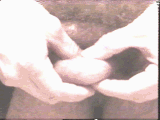
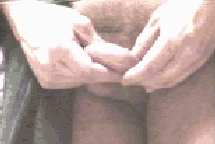 On the back of each testicle, toward the top, you will feel a comma-shaped
structure called the epididymis. This structure is responsible for the
storage of sperm. Do not confuse this for a lump, but check the epididymis
for lumps as well. At the top of the epididymis, you will feel the vas
deferns (or spermatic cord). Gently feel this cord for lumps and swelling as
well.
On the back of each testicle, toward the top, you will feel a comma-shaped
structure called the epididymis. This structure is responsible for the
storage of sperm. Do not confuse this for a lump, but check the epididymis
for lumps as well. At the top of the epididymis, you will feel the vas
deferns (or spermatic cord). Gently feel this cord for lumps and swelling as
well.
After completely examining the first testicle, go on to the next, giving it the same thorough exam.
If you notice and changes at all in your testicles, epididymis, or cord, or if you feel a lump on any of these structures, consult your doctor immediately. It could be a normal change, or the sign of infection, but you should never risk not going to the doctor because you are afraid of having cancer. Most men with this disease, prolong treatment out of fear or embarassment, and this causes substantial reduction in effective treatment. In most cases ( over 90% ) testicular cancer can be cured if found early.
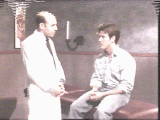 Your doctor should also examine your testicles at each yearly physical. If
cancer is suspected, ultrasound and blood tests will be run to help in the
diagnoistic procedure. If cancer is found, the testicle will be removed.
If is extremely rare that cancer is found in both testicles, so fertility
is usually not an issue, because one testicle can produce more than enough
sperm for reproduction.
Your doctor should also examine your testicles at each yearly physical. If
cancer is suspected, ultrasound and blood tests will be run to help in the
diagnoistic procedure. If cancer is found, the testicle will be removed.
If is extremely rare that cancer is found in both testicles, so fertility
is usually not an issue, because one testicle can produce more than enough
sperm for reproduction.
REMEMBER THAT TESTICULAR CANCER IS A HIGHLY CURABLE CANCER IF DETECTED EARLY. TESTICULAR SELF-EXAMINATIONS EVERY MONTH ARE YOUR BEST DEFENSE AGAINST THIS DISEASE.
For questions or comments, please feel free to email me. START TSE TODAY !
EMAIL ME HERE
CLICK HERE TO GO TO THE NATIONAL CANCER
INSTITUE
Click here to go to James Madison Univerisity
homepage
This page created by: Bruce Taylor, M.S.Ed., Instructor of Health Sciences, James Madison University